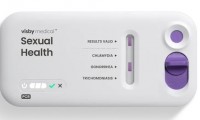-
People with chest pain more likely to develop heart and circulatory diseases
- Source: drugdu
- 291
- February 17, 2024
-
Study suggests heart stress test could transform patient diagnosis
- Source: drugdu
- 219
- February 17, 2024
-
CRISPR Test Diagnoses Mpox Faster Than Lab-Based PCR Method
- Source: drugdu
- 429
- February 16, 2024
-
Portable Rapid PCR Diagnostic to Detect Gonorrhea and Antibiotic Susceptibility
- Source: drugdu
- 328
- February 16, 2024
-
US lawmakers urge administration to take action against Wuxi
- Source: drugdu
- 226
- February 16, 2024
-
Changing protocol language and site actions are key to making trials inclusive
- Source: drugdu
- 299
- February 16, 2024
-
Millions of people to view digital prescriptions via the NHS app
- Source: drugdu
- 318
- February 16, 2024
-
NHS launches BRCA testing programme for people of Jewish descent
- Source: drugdu
- 310
- February 16, 2024
-
New Stool Test for Detecting Colorectal Cancer Could Reduce Unnecessary Colonoscopies
- Source: https://www.labmedica.com/molecular-diagnostics/articles/294800242/new-stool-test-for-detecting-colorectal-cancer-could-reduce-unnecessary-colonoscopies.html
- 472
- February 15, 2024
-
Simple Blood Test Can Predict Heart Attack Risk within Six Months
- Source: https://www.labmedica.com/molecular-diagnostics/articles/294800241/simple-blood-test-can-predict-heart-attack-risk-within-six-months.html
- 350
- February 15, 2024
your submission has already been received.
OK
Subscribe
Please enter a valid Email address!
Submit
The most relevant industry news & insight will be sent to you every two weeks.

















